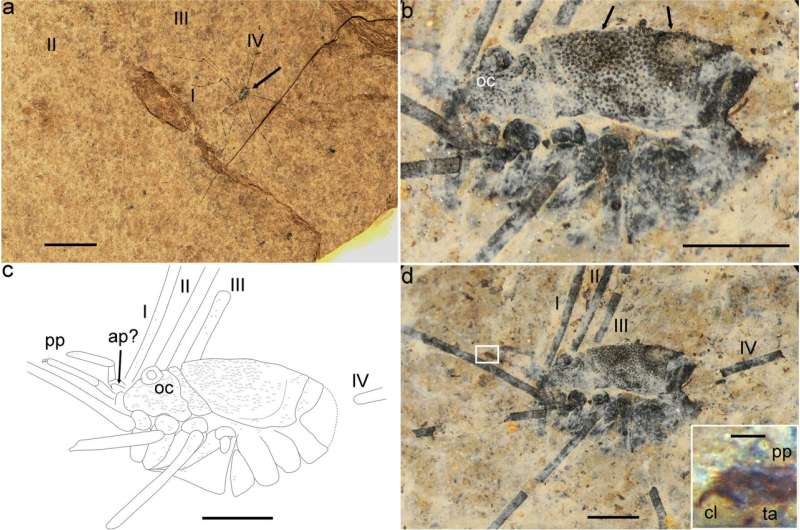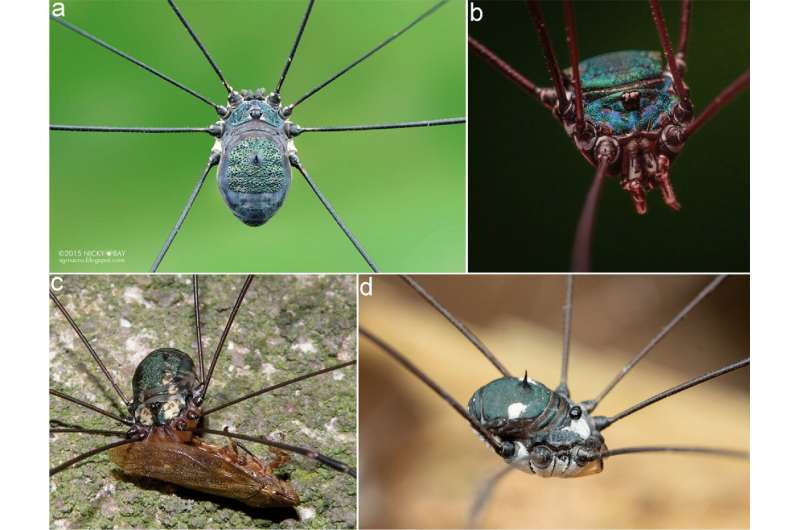This article has been reviewed according to Science X's editorial process and policies. Editors have highlighted the following attributes while ensuring the content's credibility:
fact-checked
proofread
Discovery of 48-million-year-old daddy longlegs with their iridescent, metallic appearance intact

A new study involving Christian Bartel and Jason Dunlop from the Museum für Naturkunde Berlin and Sonja Wedmann from the Senckenberg Forschungsstation Grube Messel describes several 48-million-year-old daddy longlegs (harvestmen) from the Messel mine near Darmstadt.
The work is published in the journal Palaeobiodiversity and Palaeoenvironments.
These shimmering harvestmen now live in rainforests, which supports the classification of the Messel Pit as a subtropical to tropical forest habitat. At that time, tropical arachnids lived in Germany—and probably soon again due to climate change.
The Grube Messel is one of Germany's most important fossil localities and is famous for its rich floras as well as several spectacular vertebrates such as crocodiles and early members of the group which gave rise to horses. Just as important are invertebrates and many insects and even spiders have been described. We can now add harvestmen to the ecosystem.
Several fossils of the "daddy longlegs" type have been described, and based on a large plate covering the back of the abdomen the authors could place them in a family called Sclerosomatidae. This group can still be found today across much of the northern hemisphere.

The interesting thing about these fossils was their iridescent, metallic appearance. This is probably due to so-called structural colors, where the surface of the animal's cuticle reflects light in such a way that they have a shiny appearance, even 48 million years later. This has never been seen in fossil harvestmen before.
Several living members of the family Sclerosomatidae also have this metallic appearance: these often striking arachnids are popular subjects for photographers on natural history websites. However, most of today's shiny species live in tropical parts of the world, especially in the rainforests of South-east Asia.
This ecological association would fit to the interpretation of the Messel oil shales as a volcanic lake surrounded by a warm subtropical to tropical forest. In other words, typically tropical arachnids may have roamed around in Germany 48 million years ago.
There is, however, an interesting exception from this climate connection. A strange, invasive harvestmen—possibly from Africa—with a long-legged and shiny appearance quite similar to these fossils, has been reported in recent years expanding its range through much of Europe.
Whether it was closely related to the Messel fossils is currently unclear, but it looks like metallic harvestmen will become (once again) a feature of the German fauna.
More information: Christian Bartel et al, Iridescent harvestmen (Arachnida: Opiliones: Sclerosomatidae) from the Eocene of Messel, Germany, Palaeobiodiversity and Palaeoenvironments (2024). DOI: 10.1007/s12549-024-00607-4
Provided by Museum für Naturkunde - Leibniz-Institut für Evolutions- und Biodiversitätsforschung





















